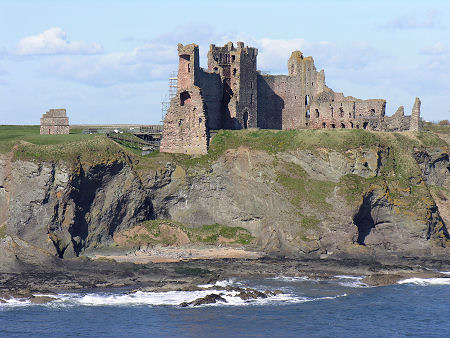 Tantallon Castle |
Archibald Douglas, 6th Earl of Angus, lived from 1490 to January 1557. He became the hated stepfather of the young King James V of Scotland and for several decades played an important role in the often fraught relations between Scotland and England. The wider picture in Scotland at the time is set out in our Historical Timeline.
Archibald Douglas was the son of George, Master of Angus, oldest son of Archibald Douglas, 5th Earl of Angus. The younger Archibald's father was killed at the Battle of Flodden on 9 September 1513, and when the 5th Earl died later that year, the younger Archibald, described by his own uncle, Gavin Douglas, as a "young, witless fool", succeeded him as 6th Earl.
In 1509 Archibald married Margaret, daughter of Patrick Hepburn, 1st Earl of Bothwell. She died in 1513 and on 6 August 1514 the 6th Earl of Angus married the widow of James IV (who had been killed at Flodden the previous year) Margaret Tudor. Margaret was mother of and Regent for the two year old James V, and elder sister of Henry VIII of England. Archibald's marriage therefore placed him at the very heart of Scottish and English politics and made him the stepfather of the infant king and his younger brother, Alexander.
Margaret's remarriage meant that under the terms of James IV's will she lost the Regency, and the following month the Privy Council appointed the John Stewart, 2nd Duke of Albany and brother of the late James IV, then resident in France, as Regent.
The Duke of Albany returned to Scotland in May 1515 and was formally made Regent in July that year. Margaret, meanwhile, was holed up in Stirling Castle with her sons, only surrendering them to Albany in August after what amounted to a genteel siege. By now pregnant with the Archibald's child, Margaret Tudor fled to England. In October she gave birth to Margaret Douglas, the future Countess of Lennox and mother of Henry Stuart, Lord Darnley, one day to be the second husband of Mary Queen of Scots, Margaret Tudor's granddaughter via James V. Archibald meanwhile returned to Scotland after patching up his differences with the new Regent, 2nd Duke of Albany.
In 1517 Margaret returned to Scotland where she discovered that in her absence Archibald had been living with a former lover, Lady Jane Stewart, and using Margaret's money to do so. When the Duke of Albany returned - again - to Scotland in 1521 after spending three years in France, Margaret formed a close alliance with him. One result was Archibald being tried for treason in December 1521. In March 1522 he was exiled to France.
In 1524, Archibald moved to London, and in that same year Margaret Tudor mounted a coup d'état that saw Albany deposed as Regent in Scotland. The 12 year old James V was brought from Stirling to Edinburgh to great popular acclaim to take up his personal rule: under the continuing close guidance of his mother. In November 1524 Archibald returned to Edinburgh with a large group of armed men and the support of Henry VIII of England, claiming that he had a right to attend Parliament. Margaret ordered the cannons at Edinburgh Castle and Holyrood House to open fire on him and Archibald retreated to his stronghold at Tantallon Castle.
Archibald then responded by effectively kidnapping the young James V, who he kept a virtual prisoner for three years. On 11 March 1528, Margaret obtained a divorce from Archibald, and shortly afterwards James V escaped and joined his mother at Stirling. His first independent act as king was to proscribe the Earl of Angus and all the Douglases, forbidding them to come within seven miles of his person and seizing their lands. Archibald again retreated to Tantallon Castle where his forces were besieged by the King. Archibald eventually left for exile in England, where he received a pension from Henry VIII.
James V died in 1542 and Archibald returned to Scotland with his estates and titles restored as an envoy of Henry VIII. His remit was to arrange a marriage between the infant Mary, Queen of Scots, and the future Edward VI of England. Conflict broke out between those in Scotland supporting an alliance with the English and those looking for closer links with France, and by 1544 Archibald had switched sides and was playing a leading role in trying to defend Scotland against English attacks during the "rough wooing" of Henry VIII. Archibald remained an unpredictable force for turbulence during the Regency of Marie de Guise. He died in January 1557.

